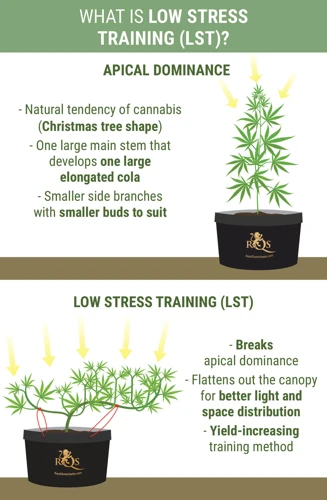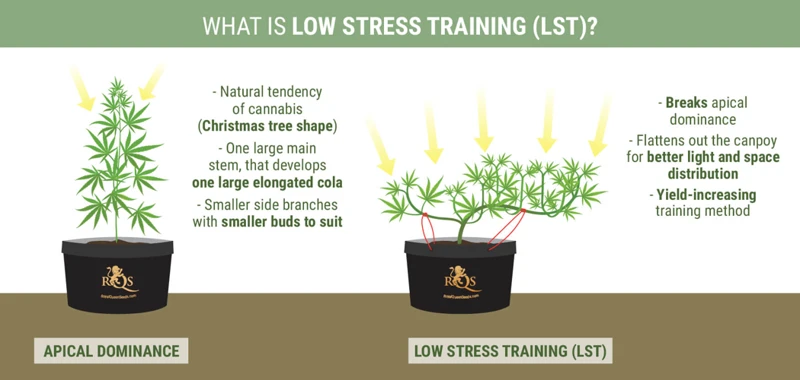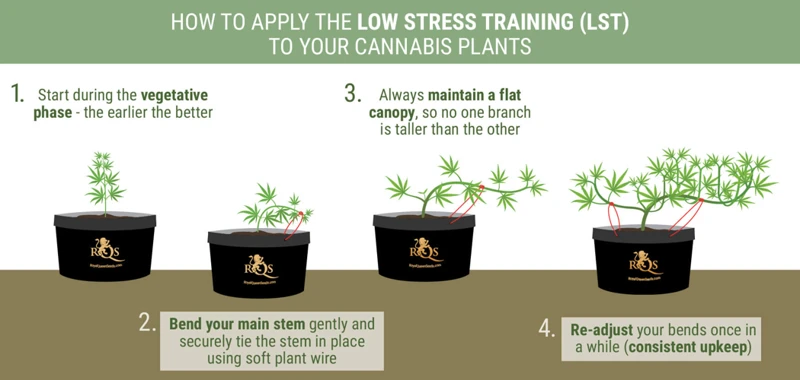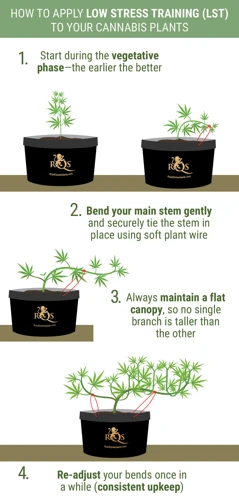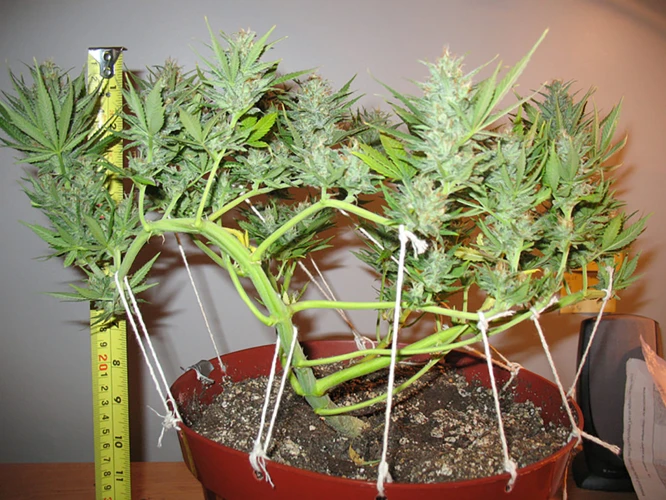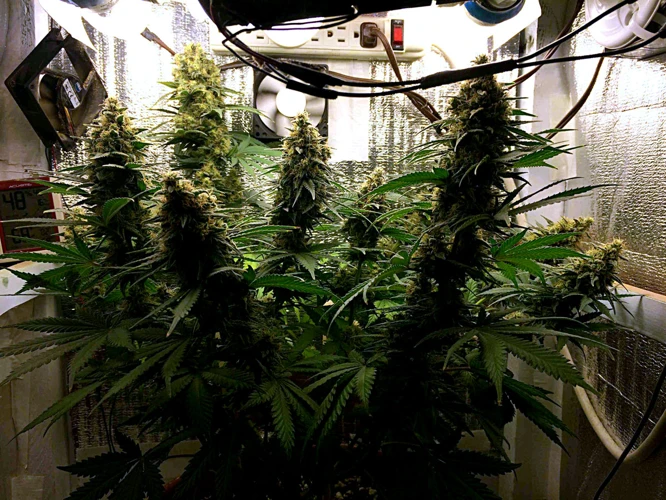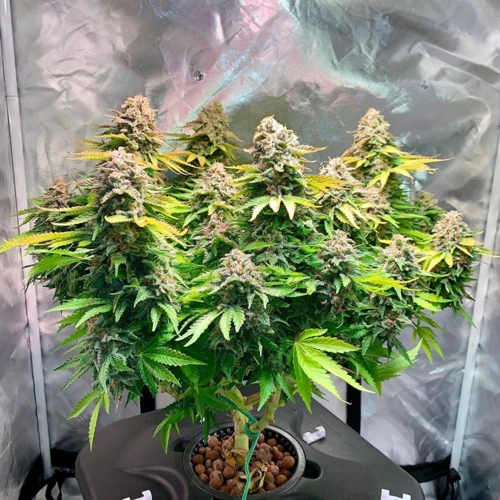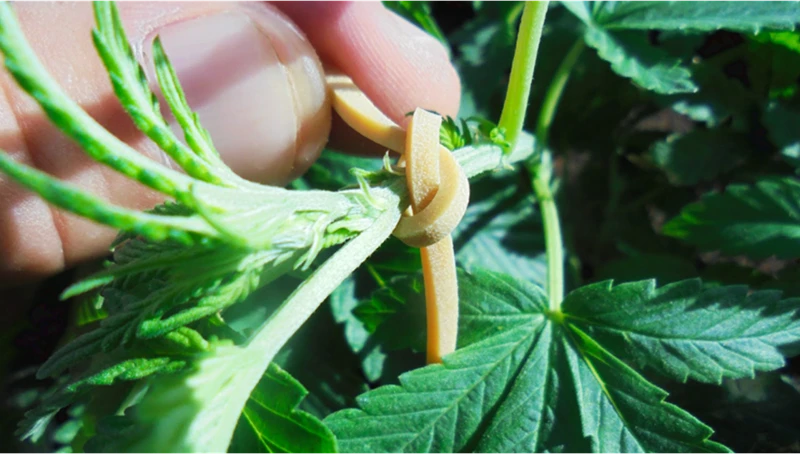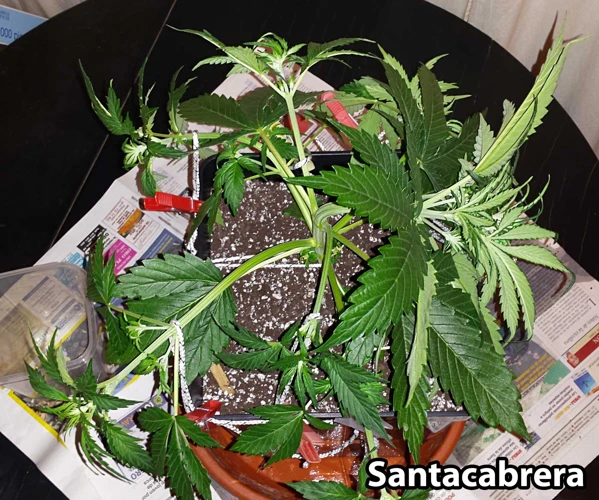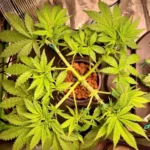
Why Low-Stress Training is Essential for Indoor Cannabis Cultivators
As an indoor cannabis cultivator, you’re always looking for ways to boost your yields and produce better quality buds. With so many plant training methods out there, it can be overwhelming to choose the right one. However, one technique that’s gaining popularity among growers is Low-Stress Training (LST). LST involves manipulating the growth of your cannabis plants without causing any physiological damage. But how does it work? And what are the benefits of using LST? In this article, we’ll dive in deeper and explore everything you need to know about LST for indoor cannabis cultivation.
What is LST and How It Works
Contents
Have you ever heard of Low-Stress Training for cannabis plants and how it can significantly boost growth? LST is a method used by many indoor cultivators to train their plants to grow horizontally, rather than vertically. This technique involves strategically bending and tying down the cannabis plant’s branches to manipulate its growth pattern. In this section of the article, we’ll delve into the workings of LST and how it can lead to increased yields and improved bud quality.
Definition of LST
LST stands for “Low-Stress Training,” which is a cannabis plant training method used to manipulate the growth of the plant without causing significant damage or stress. The LST method involves using tie-down techniques to bend and train the stems of the plant into a desired shape, creating a canopy that allows for even light distribution and increased bud production.
LST Basic Techniques:
| 1 | Bending the main stem. |
| 2 | Increasing the exposure of the lower bud sites to light. |
| 3 | Ensuring a more efficient use of resources. |
LST is a much gentler alternative to high-stress techniques such as topping or FIMming, which involve cutting off the main cola or breaking the plant’s stem. While high-stress techniques can produce results faster, they can also cause stress and damage to the plant, which can lead to stunted growth or even death.
By using the LST method, cultivators can effectively train their cannabis plants to grow in a way that maximizes yield and overall quality. LST also allows for better control of the plant’s overall height, making it possible to grow more cannabis in a limited amount of space.
The benefits of LST are numerous, and this method has become increasingly popular among indoor cannabis cultivators looking to increase their yields and improve the overall quality of their buds. By using a combination of tie-down techniques and light management strategies, cultivators can achieve their desired results while minimizing stress and damage to their plants.
How LST boosts cannabis growth
LST (Low-Stress Training) is a cannabis plant training technique that involves bending and manipulating the growth pattern of the plant without causing any stress. By using this technique, cultivators can boost the overall growth and yield of their cannabis plants. Here are some ways in which LST boosts cannabis growth:
| Benefit | Description |
|---|---|
| Increases Light Exposure | When LST is used correctly, it can help expose more of the plant to direct light. This means that more energy is absorbed by the plant, which can lead to better yields and larger buds. By keeping the branches low and spreading them out evenly, LST can help maximize light exposure. |
| Maximizes Nutrient Absorption | When done correctly, LST can help evenly distribute nutrients throughout the plant. This is because the technique helps to create an even canopy, which allows for better nutrient uptake. Additionally, by keeping the branches low and spread out, the cannabis plant can absorb nutrients from the soil more efficiently. |
| Encourages Stronger Stem Growth | By bending and manipulating the branches, LST can help stimulate stronger stem growth. This is because the technique puts pressure on the branches, which stimulates the production of auxins in the plant. Auxins are hormones that help to promote plant growth and development. As a result, LST can help create stronger and more robust cannabis plants that are better able to support larger buds. |
LST is an effective technique for boosting the growth and yield of cannabis plants. By maximizing light exposure, nutrient absorption, and stem growth, cultivators can produce more cannabis of higher quality using this simple but powerful technique.
The Benefits of LST Method
As any experienced indoor cannabis cultivator can attest, maximizing yield and potency is critical to achieving success. While there are many cultivation techniques available, one method that has proven to be highly effective is Low Stress Training (LST). By utilizing this approach, growers can promote healthier plants that produce higher yields with better quality buds. In this section, we’ll explore the specific benefits of LST, highlighting the ways in which it can be a game-changer for those looking to elevate their cannabis cultivation.
Increased Yields
One of the key benefits of LST for indoor cannabis cultivators is the potential for increased yields. By training the plant to grow horizontally rather than vertically, growers can effectively enable more of the plant to receive intense light and ultimately produce more buds.
Implementing LST techniques can also ensure that all parts of the plant receive equal exposure to the light source, which can result in more uniform growth and flowering. This can translate into a more consistent crop and a higher overall yield.
Low-stress training can encourage the growth of secondary branches and budding sites, which can lead to more flower production. When combined with other effective cultivation practices such as pruning and nutrient management, LST has the potential to substantially increase the total weight of the harvested buds.
However, it’s worth noting that the amount of yield increase from LST will ultimately depend on multiple factors including the strain being grown, the grower’s skill level, and the specific LST techniques employed. Nonetheless, the potential benefits of increased yields alone make LST a worthwhile consideration for indoor cannabis growers looking to maximize their crop’s output.
To summarize, the increased yields that can be achieved through LST make it a highly attractive cultivation method for those hoping to get the most out of their plants. By training the plant to spread out horizontally and grow more uniformly, growers can encourage greater flowering and ultimately increase their harvest.
Better Quality Buds
One of the benefits of LST for indoor cannabis cultivators is that it can lead to better quality buds. When cannabis plants are LST’d, the main cola is no longer the only dominant part of the plant. Instead, the plant is trained to develop multiple colas, which means that more buds are produced.
This not only results in increased yields (which we’ll discuss in more detail later), but it also means that the buds can develop more fully and with greater density. By opening up the plant to more light, the buds can grow and ripen more evenly. This can enhance their flavor, aroma, and potency.
Additionally, LST allows for the increased development of secondary compounds, such as terpenes, which play a crucial role in the overall experience of using cannabis. These compounds are responsible for the plant’s aroma and flavor and can also have therapeutic benefits. By increasing the number and quality of buds produced, LST can ultimately lead to better-tasting, more fragrant, and more potent buds.
Controlled Plant Height
Low-Stress Training (LST) is a popular technique used by indoor cannabis cultivators to control the height of their plants. By manipulating the growth pattern of the plant through gentle bending and tying, LST can help growers keep their plants short and bushy, rather than tall and lanky.
Here are the benefits of using LST for controlling plant height:
- Prevents overgrowth: LST helps prevent plants from growing too tall, which can be a problem in indoor growing spaces with limited height.
- Encourages horizontal growth: By spreading the plant out horizontally, LST ensures that growth is spread evenly across the entire plant. This leads to a more even canopy and increased light exposure for all parts of the plant.
- Promotes better light penetration: By keeping plants short and bushy, LST ensures that all parts of the plant are exposed to light. This can increase the overall yield of your crop as more plants get exposed to light, which leads to better photosynthesis and growth.
To perform LST for controlling plant height, growers should start training their plants when they are still in the vegetative stage. By applying pressure to the stem and bending it to a 45-degree angle, growers can cause the plant to grow horizontally instead of vertically. This can be accomplished by using various tying and bending techniques, such as the Screen of Green (ScrOG) or the Low-Stress Training with Tying methods.
It’s important to monitor your plants closely after LST to ensure that they don’t experience any stress or damage. By following the right techniques and taking care to avoid harming the plant, LST can be a safe and effective way to control the height of your indoor cannabis crop.
When to Start LSTing
Timing is crucial when it comes to Low-Stress Training (LST). Knowing when to start LSTing your cannabis plants is essential for getting the best results. The ideal time to start LSTing your plants is during the vegetative stage.
The Vegetative Stage
This stage is when cannabis plants are actively growing and developing their branches and leaves. They have not yet started to produce flowers or buds, and the stems are still young and pliable. This makes it easier to bend and shape them without causing damage.
How to Identify the Vegetative Stage
To identify when your plants have entered the vegetative stage, look for the following signs:
– Growth of new leaves and branches
– Stems becoming stronger and longer
– Vertical growth of the plant
When your cannabis plants have reached the vegetative stage, it is the perfect time to start LSTing. However, ensure that your plants are healthy and strong enough for training. Sickly plants or those with slow growth rates may not benefit from LST and may even suffer from the added stress.
Waiting Too Long
If you wait too long to start LSTing, your cannabis plants will have already grown too much, making it much more difficult to bend and shape the stems. Training them during the flowering stage can stress the plants and reduce yields.
Starting Too Early
Starting LST too early can also be detrimental to your plants. If the stems are too young and fragile, they may snap or break rather than bend, causing irreparable damage. Thus, be patient and wait until your cannabis plants are mature enough to handle LST without any harm.
How to Perform LST on Cannabis Plants
Now that we understand what LST is and its potential benefits for indoor cannabis cultivators, it’s time to learn how to perform the technique. This may seem daunting at first, but with the right tools and a step-by-step guide, it can be a straightforward process that yields great results. In this section, we will go over the tools you’ll need for LST and provide a detailed guide on how to perform the technique on your cannabis plants. Let’s get started!
Tools Needed for LST
Performing LST on cannabis plants requires specific tools that will help you bend and manipulate the branches without damaging them. Here are some tools that will be useful for LST:
- Garden ties: These are soft and stretchy ties that won’t damage the plant’s tissues. They come in various lengths and thicknesses to accommodate different plant sizes and stem widths.
- Bamboo stakes: These sturdy stakes provide support to the plant and allow you to tie down its branches. They are also reusable and eco-friendly.
- Scissors: You may need to prune some leaves or stems at times, so a sharp pair of scissors is essential to minimize damage to the plant.
- Yoyo hangers: These handy gadgets can be clipped onto the plant’s branches to provide support and encourage them to grow in a specific direction.
- Plant training wire: This is thin and flexible wire that can be wrapped around the stems to hold them in place. It is less visible than garden ties and can be easily adjusted.
Having these tools on hand will make LST easier and safer for your cannabis plants. It is important to be gentle and precise when performing LST, so using the right tools will ensure that you do not accidentally damage the stems or leaves.
Step-by-Step Guide to LST
Performing Low-Stress Training (LST) on cannabis plants is a relatively simple process that involves bending and tying down the main branches of the plant so that they grow in a horizontal direction. Here is a step-by-step guide to help you perform LST on your cannabis plants:
Step 1: Choose the Right Time – The best time to start LST is when the plant is in the vegetative stage and has at least three to four nodes.
Step 2: Prepare Your Tools – You will need some soft plant ties or twist ties, scissors or pruning shears, and gloves (optional).
Step 3: Identify the Main Stem – Locate the main stem of the plant, which is the thickest and longest stem.
Step 4: Bend the Main Stem – Gently bend the main stem of the plant down so that it is perpendicular to the soil.
Step 5: Tie the Branch Down – Using your plant ties or twist ties, secure the branch in place so that it is horizontal to the soil.
Step 6: Repeat the Process – Repeat this process with each main branch of the plant, making sure that they are all tied down and level.
Step 7: Monitor Your Plant – Check your plant daily to ensure that the branches are not being stressed or damaged by the ties. Adjust the ties as needed to ensure that the plant continues to grow and spread out.
It is important to remember that the goal of LST is to spread out the branches of the plant, not to break them. Take your time when bending and tying down the branches, and be gentle to avoid any accidental damage.
The Different Techniques of LST
Now that you understand what LST is and how it can benefit your indoor cannabis cultivation, it’s time to explore the different techniques you can use to implement this method. There are several ways to perform LST, and each one has its advantages and disadvantages depending on your specific growing situation. By using a combination of techniques, you can tailor your cannabis plant training to create the ideal environment for maximum yields and quality buds. Let’s dive into the various LST techniques and their unique benefits, so you can find the right approach for your growing needs.
Screen of Green (ScrOG)
One of the most popular techniques for LST is called “Screen of Green” or “ScrOG” for short. This method involves placing a horizontal screen above the plants and weaving the branches through the holes. This helps to spread out the canopy and create an even layer of growth.
The Benefits of ScrOG Method
This method provides several benefits for the indoor cannabis cultivator:
| Benefits | Description |
|---|---|
| Increased Yields | The ScrOG method can increase yields by allowing more light to reach lower branches, which would otherwise not receive enough light to produce quality buds. |
| Better Quality Buds | The even layer of growth created by ScrOG allows for more even light penetration and air circulation, resulting in more uniform and better quality buds. |
| Control of Plant Height | By manipulating the plants to grow horizontally instead of vertically, ScrOG can help indoor growers maintain control of the height of the plants, making them easier to manage in limited vertical space. |
How to Perform ScrOG LST
Performing ScrOG LST involves a few steps:
1. Install the screen at the desired height above the plants. Make sure the screen is sturdy enough to support the weight of the plants as they grow.
2. As the plants grow, weave the branches through the holes in the screen, spreading them out in a horizontal plane.
3. Trim away any small branches or lower leaves that are not receiving enough light or are not contributing to the overall structure of the plant.
4. Continue to gently manipulate the branches through the screen and maintain an even layer until the plants are ready for harvest.
By following these steps, indoor cultivators can expect to reap the benefits of increased yields, better quality buds, and greater control over plant height.
Super Cropping (HST)
Super Cropping, also known as High-Stress Training (HST), is a technique that involves damaging specific parts of the plant to encourage lateral growth, resulting in a bushier plant with more buds. This technique is called “high-stress” because it involves physically manipulating the plant’s structure, which can be nerve-wracking for beginner growers.
The Process of Super Cropping (HST)
1. Identify the stem that needs to be super cropped. The best time to do this is during the vegetative stage when the stem is still pliable.
2. Using your fingertips or blunt-tipped scissors, carefully squeeze and flatten the stem without breaking it. This will damage the inner tissues of the plant, triggering a stress response that leads to faster lateral growth and increased bud production.
3. Support the super cropped stem with a stake or a tie to maintain its new position. You can also wrap the damaged portion of the stem with tape or a zip tie to ensure it stays in place.
4. Allow the plant to recover from the stress before repeating the process on another stem.
The Pros and Cons of Super Cropping (HST)
Pros:
– Encourages lateral growth, resulting in a bushier plant with more buds.
– Can increase yields by up to 30% in some cases.
– Can help manage plant height by promoting lateral growth instead of upward growth.
Cons:
– Requires careful handling to avoid breaking the stem completely.
– Can cause the plant to become stressed and reduce overall yield if done improperly.
– Should only be done during the vegetative stage when the plant is still pliable.
Tips for Successful Super Cropping (HST)
– Start with healthy plants with strong stems to reduce the risk of causing irreparable damage.
– Use blunt-tipped scissors or your fingertips to avoid accidentally cutting the plant.
– Provide support for the newly super cropped stem to maintain its position.
– Allow the plant time to recover from the stress before attempting to super crop another stem.
Low-Stress Training with Tying
One of the most popular techniques of LST is Low-Stress Training with Tying, also known as LST with strings. With this technique, you’ll apply a gentle pulling on the plants’ stems, to manipulate their growth direction, using strings, ties or clips. Here are the tools and steps required for successful LST with tying:
| Tools needed for LST with tying: |
|---|
| – Strings, twist ties or soft plant ties |
| – Small hooks or anchors, to attach the strings to the container or the grow tent’s poles |
| – Scissors, to adjust the string length if needed |
Step-by-step guide to LST with tying:
1. Identify the main stem, which you want to train. Choose the one that is the strongest and has the most nodes.
2. Attach a small hook or anchor to your container or tent’s pole, at the same height as the plants’ node that you want to bend.
3. Tie one end of a string to the hook while leaving the other end hanging.
4. Loop the string loosely around the stem that you want to train, positioning it just below a node.
5. Gently pull the string in the direction that you want the stem to bend.
6. Tie the other end of the string to another hook, anchored to the container or tent pole, opposite from the previous hook, at the same height as the node where the string is looped around the stem.
7. Adjust the tension of the string, making sure it’s not too tight, which could cause damage to the plant.
8. Repeat the process for every stem that you want to train.
LST with tying is an excellent technique for spreading out the canopy of your cannabis plants, allowing more light penetration, and accelerating their growth rate. Nevertheless, be cautious not to cause too much stress to your plants as this could harm their overall health.
Tips for Successful LST
Performing Low-Stress Training (LST) the right way can help maximize yields, improve the quality of buds, and control plant height. Here are some tips for successful LST:
1. Start early: Begin LST early in the plant’s growth. Young plants are easier to bend and manipulate than mature plants.
2. Use gentle pressure: Be gentle when bending stems. Too much pressure can damage the plant and create stress.
3. Gradual bending: Always bend stems gradually, over the course of several days. This allows the plant to adjust and prevents damage.
4. Be patient: LST takes time, and it’s important to be patient throughout the process. Rushing or forcing the plant can create irreversible damage.
5. Monitor plant growth: Keep a close eye on the plant’s growth and adjust the LST technique as needed.
6. Use quality materials: Use high-quality materials for tying the plant, such as garden twine or soft wire. These materials won’t cut into the plant and cause damage.
7. Keep the plant healthy: Ensure the plant is in good health before starting LST, as it can create stress.
By following these tips, cultivators can successfully perform LST and achieve impressive results in terms of plant growth and yield.
What to Avoid When Performing LST
Performing Low-Stress Training (LST) on cannabis plants can be very beneficial for indoor cultivators, but it is important to know what to avoid when performing LST in order to prevent any damage or stress to your plants.
Avoid damaging the stem: One of the key things to avoid when performing LST is causing damage to the stem of the plant. Applying too much pressure or bending the stem too far can result in snapping, which can be detrimental to the growth and overall health of the plant. Make sure to apply gentle, gradual pressure when bending the stem, and avoid using tools that could cause damage.
Avoid unnecessary stress: While the goal of LST is to stress the plant in a controlled manner to encourage growth, it is important to avoid causing unnecessary stress to the plant. Avoid performing LST during periods of high heat or drought, as this can cause additional stress to the plant and hinder growth.
Avoid overcrowding: When performing LST, it is important to avoid overcrowding the plant with too many buds or branches. Overcrowding can cause competition for resources and light, which can ultimately result in decreased growth or even mold and disease. Make sure to give each branch or bud enough space to grow properly.
Avoid overtraining: Another thing to avoid when performing LST is overtraining the plant. While some stress is necessary to increase growth, too much stress can be harmful and result in reduced yields or even death. Make sure to monitor the plant closely and adjust your LST techniques if you notice any signs of overtraining.
Avoid using non-sterilized tools: When performing LST, it is important to use only sterilized tools to avoid introducing any harmful bacteria or pathogens to the plant. Make sure to clean and sterilize any tools you plan to use before performing LST on your plants.
By being mindful of these things to avoid, you can perform LST on your cannabis plants with confidence and reap the benefits of increased yields and better quality buds.
The Risks of LSTing
While low-stress training (LST) is a popular method for indoor cannabis growers to increase their yield, it’s not without its risks. As with any technique used in cultivating cannabis, there are potential pitfalls to be aware of. Before implementing LST in your grow operation, it’s important to understand the negative effects that can occur and how to avoid them. In this section, we will delve into the potential risks of LST and discuss ways to mitigate them.
Plant Stress
Plant stress is one of the risks associated with low-stress training. While LST is aimed at promoting horizontal growth, if it’s done excessively or improperly, it may induce stress on the plant, which can lead to poor health, reduced yield or death. Over-stretching or bending the plants too far can cause the stems to snap or break, leading to irreversible damage to the plant. Improper binding techniques can result in cutting off sap flow, leading to stunted growth, discoloration, or even death of the affected parts of the plant. Over-tying can also lead to girdling, which is a condition where the stem is choked by a tie, leading to reduced water and nutrient transport to the affected part. A plant under stress is also susceptible to pest and disease infestation, which can be detrimental to its overall health and yield. It’s important to monitor the plant closely during and after the LST process to ensure it doesn’t undergo excessive stress.
Accidental Damage
Accidental damage is a risk associated with the LST method that entails inadvertently harming plants during the training process. This can occur in various ways, and it is essential to be cautious when performing LST to avoid such a risk. Some of the instances that could lead to accidental damage include:
- Snapping the branches: When bending the branches too quickly, they may snap instead of bending. This typically happens when the branches are too rigid or not sufficiently flexible. It is crucial to gradually bend the branches to avoid snapping them.
- Breaking the main stem: The main stem is the most critical part of the plant, and breaking it can be catastrophic. When applying pressure to the branches, it is essential to ensure that the main stem is not affected.
- Wounding the plant: LST can cause wounds to the plant, which could lead to infections and disease. It is crucial to prevent the plant from coming into contact with dirty surfaces or sharp objects during training.
- Dislodging buds: Inadvertently pulling or dislodging buds from the plant can significantly reduce yields. It is essential to be gentle while handling the plants to avoid such accidental damage.
To avoid accidental damage, it is crucial to take time during the LST process and be extremely careful when handling the plants. It is also essential to use the right tool for bending or tying the branches, and avoid using tools that could harm the plant. By being cautious and diligent, cultivators can avoid accidental damage and ensure the success of the LST method.
LST vs. Other Plant Training Strategies
When it comes to indoor cannabis cultivation, growers have a range of plant training techniques at their disposal. Among the most popular are Low-Stress Training (LST), High-Stress Training (HST), Topping, and FIMming. Each method has its own unique advantages and disadvantages, and choosing the right one for your plants can be a perplexing decision. In this section of the article, we’ll compare and contrast LST with other plant training strategies, highlighting the pros and cons of each. By the end, you’ll have a better understanding of which method may be best suited to your indoor cannabis cultivation needs.
High-Stress Training (HST)
High-Stress Training (HST) is another popular plant training method for indoor cannabis cultivation. Unlike LST, HST is a more aggressive technique that involves removing or damaging parts of the plant’s anatomy to force growth in specific areas. This method involves topping the plant, or removing the top portion of the stem, in order to promote lateral growth.
One of the benefits of HST is that it can lead to even more dramatic increases in yield compared to LST. By removing the top portion of the plant, HST redirects the plant’s growth hormones to the lateral branches, which results in more bud sites and a more bushy and robust plant.
However, HST is a riskier method and requires careful attention to avoid causing too much stress or harm to the plant. It’s important to note that HST can significantly slow down the plant’s growth for a short period of time and delay the flowering process, so it’s not recommended for growers seeking a quick turnaround time.
Here is a comparison table outlining the key differences between LST and HST:
| LST | HST | |
|---|---|---|
| Methodology | Low-stress; training plant branches to grow horizontally | High-stress; damaging plant anatomy to promote lateral growth |
| Yield | Good yield increases, but not as dramatic as with HST | Potential for significant yield increases |
| Risks | Minimal risk of plant damage or stress | Potentially high risk of plant damage or stress |
| Timing | Can be done throughout the vegetative stage | Best done early in the vegetative stage |
It’s worth noting that both LST and HST have their own unique benefits and drawbacks, and the decision to use one method over the other ultimately depends on the indoor grower’s personal preferences, experience level, and goals.
Topping
One of the most common plant training techniques is topping. This method involves cutting off the top of the plant’s main stem in order to promote the growth of lateral branches. Here are some key points to keep in mind when using topping:
- Timing: It’s best to top your plants when they have at least 4-6 nodes, which usually takes about 4-6 weeks after germination.
- Cutting: Carefully cut the main stem directly above a node with a sharp, clean pair of scissors or pruning shears. This will cause the plant to redirect its energy to the lateral branches and promote their growth.
- Recovery: After topping, your plant will need time to recover before it starts growing again. Be patient and wait for new growth to appear before performing any additional training.
- Benefits: Topping can help to create a more even canopy, increase yields, and promote more lateral growth. However, it is a more invasive technique that can cause more stress to the plant compared to LST.
While topping can be an effective technique for some growers, it may not be the best choice for those who want to keep their plants low and have limited vertical space. Additionally, topping can slow down the vegetative phase of growth and delay the overall timeline of the plant’s life cycle.
FIMming
FIMming is another plant training technique that can be used in conjunction with LST or on its own. FIM stands for “f**k, I missed” and refers to the accidental discovery of this technique by a grower who was attempting to “top” their plants but accidentally left a small part of the top intact. FIMming is a less stressful method of topping that allows for increased plant bushiness and multiple colas.
How to FIM:
- Choose a plant that has grown at least five sets of leaves.
- Identify the new growth at the top of the plant and locate the tip where the new leaves begin to emerge.
- Using a sharp, sterile pair of scissors, cut approximately 80% off of the tip at a 45-degree angle, leaving a small amount of growth intact.
- Within a week, the plant will produce new shoots at the site of the FIM cut.
Advantages of FIMming:
- Increased plant bushiness, leading to more potential colas and higher yields.
- Less stressful for the plant compared to traditional topping methods.
- Can be performed multiple times on the same plant for even more bushiness and potential colas.
However, it’s important to note that FIMming is a delicate process and requires precision and care to prevent accidentally cutting too much off and causing harm to the plant. It can also result in slower plant growth initially as the plant recovers from the procedure. As with any plant training method, it’s important to research and fully understand the technique before attempting it on your own plants.
FAQs About LST Method
Are you still not sure about the LST method? Maybe you have some questions that have been lingering in your mind. Well, worry no more! We have compiled a list of frequently asked questions to help clear up any doubts you have. From its effects on trichome development to its compatibility with autoflower strains, we’ve got you covered. Keep reading to learn everything you need to know about LST.
Is Low-Stress Training Suitable for Autoflowering Strains?
Autoflowering strains have unique characteristics that differentiate them from other cannabis varieties. These strains grow and flower in a short amount of time, typically within 2-3 months. One concern among indoor growers is whether low-stress training (LST) is suitable for autoflowering strains. Here are some important factors to consider:
- Timing: Autoflowering strains have a very short vegetative period, which means that any training technique must be done quite early to avoid causing undue stress. LST should be started as soon as possible, ideally within the first few weeks of growth. This allows the plant to fully recover and continue growing before it begins to flower.
- Intensity: As the name suggests, LST is a low-stress technique. This means that the pressure applied to the plant is gentle and gradual, allowing it to adapt to the new growth pattern without causing damage. However, it is important to avoid overtraining or applying too much pressure at once, as this can lead to stunted growth or even plant death.
- Genetics: While many modern autoflowering strains are bred to be more resilient and adaptable, some varieties may not respond well to training techniques like LST. It is important to research the genetics of your specific strain and understand its growth patterns and tendencies. This will give you a better idea of whether LST is a suitable method for that particular plant.
- Grow Environment: Lastly, it is important to consider the overall conditions of your grow environment. Autoflowering strains typically grow well in smaller spaces with less intense light, so LST may not be necessary to control height or increase yields. However, if your grow space is limited, LST may be a good way to maximize your yield while still maintaining a manageable plant size.
Low-Stress Training can be suitable for Autoflowering strains, however, it is necessary to take a few precautionary measures to ensure successful growth. It is crucial to start LST early, apply gentle pressure, consider genetics, and take into account the growth environment. With proper planning and execution, LST can help increase yields and quality for autoflowering strains.
Does LSTing Affect Trichome Development?
Trichomes are small resinous glands that develop on the surface of the cannabis plant’s leaves and buds. These trichomes contain cannabinoids such as THC and CBD, which are highly prized by cannabis enthusiasts. So, it’s understandable that growers are concerned about whether LSTing can affect trichome development.
Fortunately, LSTing does not have a negative impact on trichome development. In fact, many growers believe that LST can actually increase trichome production by exposing more of the plant to light and reducing overall stress.
The trichomes on a cannabis plant are highly sensitive to environmental factors, including light exposure and temperature. By utilizing LST methods, growers can ensure that their plants are receiving optimal light exposure, which can lead to increased trichome production. Additionally, LST helps to lower overall stress levels for the plant, which can also help to promote healthy trichome development.
However, it is important for growers to be mindful of their LST techniques and not inadvertently cause damage to the plant in the process. Over-stressing the plant can lead to reduced trichome production and a decrease in overall yield, so it’s important to balance the benefits of LST with the risk of damaging the plant.
LST is a safe and effective method for promoting healthy cannabis growth, and it doesn’t have any negative effects on trichome production. With careful attention to technique and plant health, growers can expect to see both increased yields and high-quality trichome production in their cannabis plants.
How Long Does LSTing Take?
When it comes to LSTing, one of the most common questions is how long it takes for the training to show results. The answer is not straightforward as it depends on different factors such as the strain, growing conditions, and the LST technique used. Here are some points to keep in mind:
- Patience is key: LSTing is not a magic technique that produces immediate results. It takes time for the plant to respond to the training and for the growth patterns to change.
- Expect gradual changes: LSTing involves manipulating the plant’s growth over time, so the changes are gradual. It may take a few weeks to see noticeable changes in plant structure and canopy development.
- The vegetative stage is the best time to train: LST is most effective during the vegetative stage when the plant is still developing its structure. The earlier you start, the more time you have to manipulate the plant’s growth.
- Be mindful of the plant’s growth rate: Some strains respond better and faster to LST than others. The plant’s overall health, vigor, and growth rate may also impact how quickly it responds to LST.
- The training duration depends on the technique: Different LST techniques require varying amounts of time and effort. For instance, the ScrOG method involves training the plant to grow under a screen, which may require many weeks of LST to fill the screen adequately.
LSTing is not a one-size-fits-all technique, and the time it takes to see results depends on several factors. However, with patience, careful manipulation, and consistent efforts, LST can help you achieve a more robust and productive cannabis garden.
Conclusion
In conclusion, LST is an effective and efficient method for indoor cannabis cultivators to improve their yield, quality, and overall plant health. By gently bending and shaping the stems and branches of the plant, cultivators can control the plant’s growth and ensure a bountiful harvest.
One of the biggest benefits of LST is that it allows for controlled plant height. This is important for indoor growers who have limited space and want to maximize their growing area. By keeping the plant short and wide, rather than tall and narrow, they can increase their yield and make the most of their growing space.
Another advantage of LST is its ability to increase yields and improve the quality of buds. By spreading out the plant’s branches, cultivators can give each bud more exposure to light and air, which can result in bigger, denser, and more potent buds at harvest time.
However, it is important to note that LST is not without its risks. Plant stress and accidental damage can occur if not done correctly, and it may not be as suitable for some strains or with certain growing techniques, such as hydroponics.
Overall, LST is a great tool for cannabis growers who want to optimize their indoor growing experience. By following the proper techniques and taking the necessary precautions, cultivators can enjoy a successful, bountiful harvest with improved quality and yield.
Frequently Asked Questions
Can LST be done on all strains of cannabis?
Yes, LST can be performed on all strains of cannabis.
Is LST suitable for indoor and outdoor growers?
While LST is primarily used by indoor growers due to space constraints, it can also be used by outdoor growers to control plant height and increase yields.
Will LSTing affect the potency of the buds?
No, LSTing does not affect the potency of the buds.
Can LST be performed on plants during the flowering stage?
While it is possible to LST plants during the flowering stage, it is best to perform LST during the vegetative stage to avoid any potential stress on the plant.
What is the best time of day to perform LST?
LST can be performed at any time of day, but it is best to do it during the day when the plant is actively growing.
How long does it take to see results from LST?
Results from LST can be seen within a few days to a week, but the full effects may not be noticeable until later in the plant’s growth cycle.
Can LST be done without using any tools?
Yes, LST can be performed without tools, but using tools such as plant ties or bamboo stakes can make the process easier and more efficient.
What is the difference between LST and HST?
LST (Low-Stress Training) involves gently bending and tying down the plant to encourage lateral growth, while HST (High-Stress Training) involves more aggressive techniques such as super cropping and topping to stunt the plant’s growth.
Will LSTing result in a longer vegetative stage?
LSTing may result in a slightly longer vegetative stage as the plant takes time to recover from the stress of being bent and tied, but it will ultimately result in better yields and higher quality buds.
Can LST be done on plants grown in hydroponic systems?
Yes, LST can be performed on plants grown in hydroponic systems, but extra care must be taken to avoid damaging the roots.

